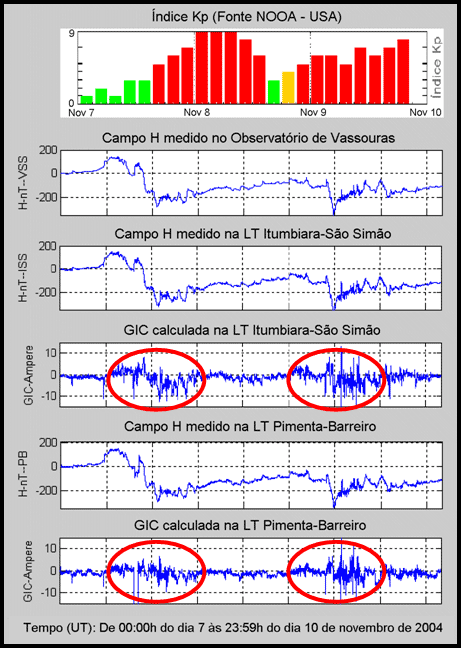ELECTROMAGNETIC INDUCTION EFFECTS ON THE EARTH: INDUCED ELECTRICAL CURRENTS INTO TECHNOLOGICAL SYSTEMS AT THE SURFACE
Geomagnetic variations observed by magnetometers at the surface of the Earth are composed of two parts, one component derived from the external electrical flux in the ionosphere and magnetosphere, and the other from induced electrical currents in the interior of the Earth. Basically, these currents result from the interaction between the geomagnetic field and the conductive Earth, linked by the orthogonal coupling between the geomagnetic and telluric fields. The amplitudes of the induced telluric currents vary according to the frequency, the rate of geomagnetic field variations and also to the distribution and anisotropy of conductivity in the crust and mantle of the Earth.
During geomagnetic storms, the magnitude and the rate of the geomagnetic field variation are very large, in relation to quiet periods. Geomagnetic storms cause field variations on the order of 1000 to 2000 nT at high latitude regions, but much less, on the order of 200 to 300 nT, at low (equatorial) and mid latitudes, such as in Brazil. The occurrences of geomagnetic storms produce geomagnetically induced currents (GIC) in technological systems deployed at the surface of the Earth, such as electrical power transmission lines, metallic ducts, telephone and television cables. The magnitude of GIC is largely enhanced when the rate of variation of the geomagnetic field is intense and rapid, and the solid Earth has a very high electrical resistivity.
In the case of electric transmission lines, GIC flows between the grounding points of power transformers and along electric power transmission lines connecting the transformers, with characteristics of continuous currents (quasi DC). The GIC can cause severe damages, affecting simultaneously many technological systems over a large region, with serious social and economic consequences. The occurrence of GIC can alter the power line operation, changing the power transformer mode from linear to non-linear, altering the harmonics, and elevating the temperature. These changes saturate transformer cores and may lead to various damages possibly causing large scale power failures, such as local and regional blackouts.
In the case of metallic ducts for petroleum and gas, the problems caused by the occurrence of GIC are related to the mitigation of corrosion of the metallic duct, associated with an anomalous enhancement of the potential difference between the soil and the surface of the metallic duct.
MODElS OF GIC EFFECTS ON TECHNOLOGICAL SYSTEMS AT THE SURFACE
The likely occurrence of GIC in long and linear conductors of technological systems deployed at the surface of the Earth can be predicted by registering the parameters of the geomagnetic field variations during magnetic storms and estimating the electrical resistivity of the Earth under the region where the technological systems are installed.
Two empirical approaches are usually employed in the models: i) a more simple one takes into consideration the time derivative of the horizontal magnetic components (dH/dt and dD/dt, respectively NS and EW components), during the occurrence of the storm; ii) a more complex one considers the physical processes that constrain the induction within the Earth, as a function of the frequency and amplitude of the incident electromagnetic signal.
In both cases, analyses are made of the magnetic signal during the temporal evolution of the geomagnetic storm, in the three components: H (NS), D (EW) and Z (vertical). Using the time series data of the geomagnetic variation, the magnitude is estimated as a function of the frequency and the parameters of polarization, elliptic form and azimuth of the waves. In the more complex model, the magnetic induction is also analyzed with models of the conductive characteristics of the crust and mantle, obtained by geophysical sounding methods, such as magnetotellurics, in the areas where the technological systems are deployed.
The eventual occurrence and magnitude of GIC can be estimated directly with a current meter based on a Hall sensor installed on the cable linking the neutral point of the transformer of power lines and the Earth, and also, indirectly, with magnetometers deployed underneath the power lines and along the metallic ducts. In order to simulate and quantify the effects of GIC on technological systems, it is necessary to have, also, inputs of its technical parameters.

Figure: illustration of GIC (red circles) occurring in electric power lines between the cities of Itumbiara–São Simão (state of Goiás) and Pimenta-Barreiro (state of São Paulo). The event is related to the geomagnetic activity which took place from the 7th to 10th of November 2004, as shown by the Kp index (at the top) and geomagnetic variations recorded at the Observatório de Vassouras (state of Rio de Janeiro) and magnetometers installed underneath the two transmission lines.





